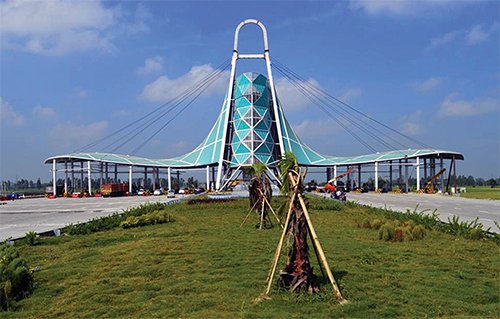So, there is a need to try and convert these local cars to FASTag. Every concessionaire has got a requirement to take care of the local cars through some sort of electronic medium. Different concessionaires are doing it differently using their smart cards and some other techniques. We have tried to take it to the FASTag platform after discussing with the banks and NPCI and that has started showing some results. NHAI also has recently issued a circular making it mandatory that all local and monthly passes be issued only through FASTag.
One datapoint is a project near Panipat where, in September 2017, we had 3% FASTag volumes which moved up to 17% by September 2018. This jump over a one-year period was mostly due to the local cars getting converted from Smart Cards to FASTags. But in trunk routes and long highways, we don’t see much of car adoption.
The current system of FASTag requires every truck to have a unique bank account and unique FASTag. A lot of transporters in the country having 1000 -2000 trucks, don’t have the bandwidth or the clerical setup to manage 2000 accounts on a monthly basis or on a trip basis because the technology does not allow interoperability. This is one reason why most trucks owners are not willing to paste the tag on the windscreen. We are still seeing many trucks having tags coming out from their pocket at the plaza which is against the principles of the programme. But this is one challenge they face. Some issuer banks have of-late started giving group accounts, which is a welcome improvement.
 State Transport buses pose the next major challenge. At least, in six of our Toll Plazas , the state-run transport companies have come back and surrendered the FASTag. None of the state transport departments have got the bandwidth to manage 5000 to 6000 bank accounts on a monthly basis and keep recharging it. They are saying if the concessionaire were to control it we only need to generate one demand draft and you handle the remaining. So, these are some of the things we have been discussing with NPCI and NHAI. If some structural changes are made, the adoption will be much higher.
State Transport buses pose the next major challenge. At least, in six of our Toll Plazas , the state-run transport companies have come back and surrendered the FASTag. None of the state transport departments have got the bandwidth to manage 5000 to 6000 bank accounts on a monthly basis and keep recharging it. They are saying if the concessionaire were to control it we only need to generate one demand draft and you handle the remaining. So, these are some of the things we have been discussing with NPCI and NHAI. If some structural changes are made, the adoption will be much higher.
When it comes to settlement from the concessionaire side, there are problems. There are many under-deliveries, charge-back issues but the positive side is that things are settling down. When we started the program and it kicked up steam in December 2016, we had a situation where under 34 to 40 heads, we were getting rejections on a daily basis. But in the last six months, it has been largely restricted to some blacklist rejections or some charge back once in a while. So, I believe that the system has been stabilised; there are some bottlenecks that we need to overcome with respect to blacklist and other kind of issues like class discrepancy. We are in an improvement mode and the scenario looks positive.
All of us aspire for the gantry-based tolling without boom barriers. We have adopted passive RFID technology where irrespective of the improvements that the concessionaire makes on the reading and other capabilities, we still have to check every FASTag against the blacklist register. As long as we need to do that I am not very sure how we are able to get to that level of speed.
Technology
 Sandeep Pawar: Talking about technology, five years back we were only concentrating on the cash receipts. Way back in 1998, we were only talking about the receipts; there was no automation also. So till 2015, before the pilots were going on in ETC, everybody was concentrating on the cash receipts and the AVC part. After the ETC concept has been implemented, we are now thinking of identifying the vehicles properly. We are doing it with the RFID a passive technology. The technology must be coupled with some purse-based device where the transaction can be maintained. The exact RFID account or the FASTag account can be linked with the smartcard wherein we can maintain the purse and we can have the current transactions done. So, the technology, yes, I mean now after the SLA guidelines have come, NHAI is also demanding for uptimes because that is also necessary. We have converted all the lanes to hybrid but then they have to be on also all the times to increase the ETC. So, this is a good initiative by the government and NHAI.
Sandeep Pawar: Talking about technology, five years back we were only concentrating on the cash receipts. Way back in 1998, we were only talking about the receipts; there was no automation also. So till 2015, before the pilots were going on in ETC, everybody was concentrating on the cash receipts and the AVC part. After the ETC concept has been implemented, we are now thinking of identifying the vehicles properly. We are doing it with the RFID a passive technology. The technology must be coupled with some purse-based device where the transaction can be maintained. The exact RFID account or the FASTag account can be linked with the smartcard wherein we can maintain the purse and we can have the current transactions done. So, the technology, yes, I mean now after the SLA guidelines have come, NHAI is also demanding for uptimes because that is also necessary. We have converted all the lanes to hybrid but then they have to be on also all the times to increase the ETC. So, this is a good initiative by the government and NHAI.
As from system integrator point of view, we are trying to keep the infrastructure available to accept the payments but again the limitation is the technology that we are using, it is not allowing us to remove the blacklist concept, somehow that needs to be addressed, and this is the concern.
The same can be done with the high security number plate because that is also an RFID device that will give you a unique identification of that vehicle all over the country. So, I think some combination of technology with RFID, existing infrastructure or the backend, needs to be integrated to overcome this problem. Otherwise, we are going to fight with the identification because the technology itself says 99.4 percent.
The second thing which is being discussed is that very few cars go out of the city limits. When the new cars come to the toll, they are unaware that they are having a tag. They have done their KYC and they have balance in the RFID account, they pay also and the tag is also deducted. The dealer while selling the car is doing the KYC but he is not educating the client why he is doing it. So, I think that also needs to be addressed.
Now the question is, is FASTag easily available?
As per current situation, banks are issuing the tags to the user but many cases have been observed in few cases that the class is not followed or the class that the tag has is different than the type of the vehicle. It is not creating any problem as far as the revenue is concerned to the concessionaire because when it goes to the mapper it gives you the correct class as mapped with National Payments Corporation of India but then it creates a problem on the ground level for the, AVC. So, this is unnecessarily increasing the burden of acquirer banks for doing the audit. Again, some streamlining needs to be done in a tag which is having a class inside that needs to match and physical distribution needs to be done very properly. AVC accuracy is very much important to avoid unnecessarily overheads in ETC transaction processes.
 TrafficInfraTech Magazine Linking People Places & Progress
TrafficInfraTech Magazine Linking People Places & Progress